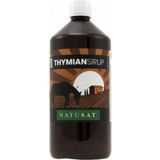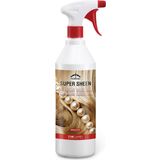Intestinal Rehabilitation: New Structure of the Intestinal Flora
The horse's intestine is an important but sensitive organ. If the intestinal flora is disturbed, problems arise. Then it may be necessary to build up the intestinal flora again.
A build-up of the intestinal flora is not a quick fix. A number of preliminary examinations are also necessary for long-term success, which means effort. Nevertheless, it can pay off to bring the intestinal flora of a horse back into shape with special bacterial cultures.
The horse's intestine
First, let's look at the structure of the horse's intestine. It is around 30 meters long and has a liquid volume of 200 litres. The small intestine makes up around 20 meters of these 30 meters. Its task is to mix the food masses from the stomach. In addition, the nutrients are broken down there and absorbed through the intestinal mucosa.
The rest of the food then goes to the first part of the colon, the appendix. There the crude fibre is broken down and gets further into the colon and finally into the rectum, whereby more and more water is withdrawn from the feed mass and it is finally pressed into its typical shape.
The intestinal flora plays an important role in all of these processes. This means all microorganisms that live in the intestine. Not only do they utilise nutrients, but they also stimulate bowel movements and ward off pathogens. The intestinal bacteria are essential for the health of our horses. If there is an imbalance in the intestinal flora, problems such as colic, flatulence, increased susceptibility to infections or illnesses arise.
When is it advisable to clean up the intestinal flora in horses?
Rehabilitation of the intestinal flora is always good when it no longer works properly. The reasons for this are diverse. They range from suboptimal housing conditions to the aftereffects of medication. Worming treatments also put a considerable strain on the intestinal flora of horses and can make rehabilitation necessary.
Basis for a successful renovation
Not every intestinal rehabilitation in horses is crowned with success. Often this is because the foundation is not laid. It is important to create the right conditions.
First of all, the liver function should not be disturbed, which guarantees a high flow of bile. Furthermore, care must be taken when feeding that the horse receives as few chemicals, preservatives and sweeteners as possible. The feeding must always be tailored to the needs of the horse and should be as natural as possible. Roughage as a staple food is compulsory, and animal-appropriate keeping and at least twelve hours of daily eating time should be ensured.
The bacteria that are fed for the remediation process need certain nutrient media in order to survive and multiply. The intestinal environment must therefore be right so that the bacteria also have a chance. If the environment is polluted, there are not enough nutrients, if it is too acidic, pathogenic germs and fungi settle instead of good bacteria. These produce metabolic products that can trigger various complaints.
Pro- and pre-biotics
Today probiotics play an important role in the intestinal rehabilitation of horses. But only a fraction ever makes it to the intestine. Therefore, probiotics must always be fed over a longer period of time. In the long term, however, they improve the digestibility of crude fibres in the large intestine, they promote the bacterial function of the intestinal mucosa, ward off pathogens and generally have a positive effect on the composition of the intestinal flora. The metabolically active yeast cells also promote colonisation of the intestinal flora with anaerobic bacteria that have a fibre-splitting effect.
In addition to prebiotics, there are also various prebiotics. These are complex carbohydrates that can only be broken down by certain microorganisms in the intestine and thus stimulate their growth.
It's not magic!
Intestinal rehabilitation is not witchcraft, but in order for it to be crowned with success in the long term, the reasons for the imbalance in the intestinal flora must first be found and eliminated. Only if the intestinal environment and the feeding or keeping conditions are right do the probiotics and prebiotics ingested with food have a chance of having a positive effect. It is best to always do an intestinal rehabilitation in conjunction with veterinary supervision, because this is the most likely way of success.
Latest reviews
-
 5.0 (2)
5.0 (2)EquiPower Probiotic, 2 kg
- Supports the intestinal flora
- Supports digestion
- Optimal nutrient supply
£57.50 (£28.75 / kg)Delivery by January 06
-
 4.8 (19)
4.8 (19)NATUSAT Black Cumin Pellets, 5.000 g
- Highest quality
- Strengthens the immune system
- Ideal for allergies
£23.00 (£4.60 / kg)Delivery by January 06
-
 4.8 (13)
4.8 (13)NATUSAT Thyme syrup, 1.000 ml
- Supports healthy airway function
- Only includes pure, biogenically grown ingredients
£31.00 (£31.00 / l)Delivery by January 12
-
 5.0 (3)
5.0 (3)VEREDUS Super Sheen, 1 l
- Knot-free for 2 weeks
- Shortens the cleaning time
- Does not stick or grease
£24.50 (£24.50 / l)Delivery by January 06
Magazine Articles:
-
Great Britain: Free standard delivery from £79.90
-
Free
returns -
We operate in a
climate-conscious manner. More than 10.150 products
